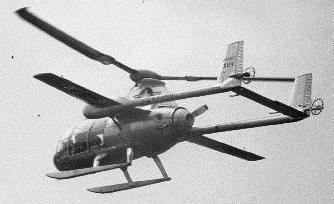 | ||
Slowed rotor is a concept in designing and flying certain rotorcraft. Reducing the rotational speed of the rotor reduces the drag, enabling the aircraft to go faster and/or fly more economically.
Contents
Background
Rotors of conventional helicopters are designed to operate at a fixed RPM (within just a few percent), causing suboptimal operation in large parts of the flight envelope.
Two main issues restrict the speed of rotorcraft:
These (and other) problems limit the practical speed of helicopters to around 160–200 knots (300–370 km/h). At the extreme, the theoretical top speed for a rotary winged aircraft is about 225 knots (259 mph; 417 km/h), just above the current official speed record for a conventional helicopter held by a Westland Lynx, which flew at 400 km/h (250 mph) in 1986 where its blade tips were nearly Mach 1.
Theory
For rotorcraft, advance ratio (or Mu, symbol
The "relative blade tip speed" u is the tip speed relative to the aircraft (not the airspeed of the tip). Thus the formula for Advance ratio is
When the rotor blade is perpendicular to the aircraft and advancing, its tip airspeed Vt is the aircraft speed plus relative blade tip speed, or Vt=V+u. At mu=1, V is equal to u and the tip airspeed is twice the aircraft speed.
At the same position on the opposite side (retreating blade), the tip airspeed is the aircraft speed minus relative blade tip speed, or Vt=V-u. At mu=1, the tip airspeed is zero. At a mu between 0.7 and 1.0, most of the retreating side has reverse airflow.
Although rotor characteristics are fundamental to rotorcraft performance, little public analytical and experimental knowledge exists between advance ratios of 0.45 to 1.0, and none is known above 1.0 for full-size rotors. Computer simulations are not capable of adequate predictions at high mu. The region of reverse flow on the retreating blade is not well understood, however some research have been conducted, particularly for scaled rotors. The US Army Aviation Applied Technology Directorate runs a supporting program in 2016 aiming at developing transmissions with a 50% rotor speed reduction.
The profile drag of a rotor corresponds to the cube of its rotational speed. Reducing the rotational speed is therefore a significant reduction of rotor drag, allowing higher aircraft speed or lower power consumption. A conventional rotor such as the UH-60A has lowest consumption around 75% rpm, but higher aircraft speed (and weight) requires higher rpm.
A rotor disk with variable radius is a different way of reducing tip speed to avoid compressibility, but blade loading theory suggests that a fixed radius with varying rpm performs better than a fixed rpm with varying radius.
Aircraft
Traditional helicopters get both their propulsion and lift from the main rotor, and by using a dedicated propulsion device such as a propeller or jet engine, the rotor burden is lessened. If wings are also used to lift the aircraft, the rotor can be unloaded (partially or fully) and its rotational speed further reduced, enabling higher aircraft speed. Compound helicopters use these methods, but the Boeing A160 Hummingbird shows that rotor-slowing is possible without wings or propellers, and regular helicopters may reduce turbine RPM (and thus rotor speed) to 85% using 19% less power. Alternatively, research suggests that twin-engine helicopters may decrease consumption by 25%-40% when running only one engine, given adequate height and velocity well inside the safe areas of the height–velocity diagram.
As of 2012, no compound or hybrid wing/rotor (manned) aircraft has been produced in quantity, and only a few have been flown as experimental aircraft, mainly because the increased complexities have not been justified by military or civilian markets. Varying the rotor speed may induce severe vibrations at specific resonance frequencies.
Contra-rotating rotors like on Sikorsky X2 solve the problem of lift dissymmetry by having both left and right sides provide near equal lift with less flapping. The X2 deals with the compressibility issue by reducing its rotor speed from 446 to 360 RPM to keep the advancing blade tip below the sound barrier when going above 200 knots.
List of slowed rotor aircraft
Sorted by year. Click <> to sort by other parameters.
